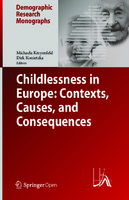Childlessness in Europe
Contexts, Causes, and Consequences
Contributor(s)
Kreyenfeld, Michaela (editor)
Konietzka, Dirk (editor)
Collection
European Research Council (ERC)Language
EnglishAbstract
In recent decades, levels of childlessness have been increasing rapidly in most
European countries. German-speaking countries seem to be at the forefront of this
development, as more than 20% of the women living in Germany, Switzerland, and
Austria who are now reaching the end of their reproductive period will remain
childless. But other European countries, such as the UK and Finland, also report
high levels of childlessness. Eastern and Southern Europe did not have high levels
of childlessness a decade ago, but are now seeing steady increases. This book provides
an overview of the recent trend toward a “life without children” across Europe.
It seeks answers to questions like: What are the determinants of childlessness in the
twenty-first century? Is there an unbroken trend in childlessness, or is there evidence
of trend reversals? How does the likelihood of remaining childless differ
across social strata? To what extent do economic uncertainties affect childlessness?
How do fertility desires evolve over the life course? To what extent does the situation
of a woman’s partner affect her fertility decisions? How far can we push the
biological limits of fertility? What role can assisted reproduction play in reducing
childlessness? How many men fail to have children of their own? What impact can
family policies have on fertility decisions? Can governments reverse the trend
toward childlessness—and, if so, should they?
Keywords
Childlessness; Demography; Austria; Fertility; Finland; Germany; Sweden; SwitzerlandDOI
10.1007/978-3-319-44667-7ISBN
9783319446653; 9783319446677OCN
1051778908Publisher
Springer NaturePublisher website
https://www.springernature.com/gp/products/booksPublication date and place
2017Grantor
Series
Demographic Research Monographs,Classification
Family and health


 Download
Download